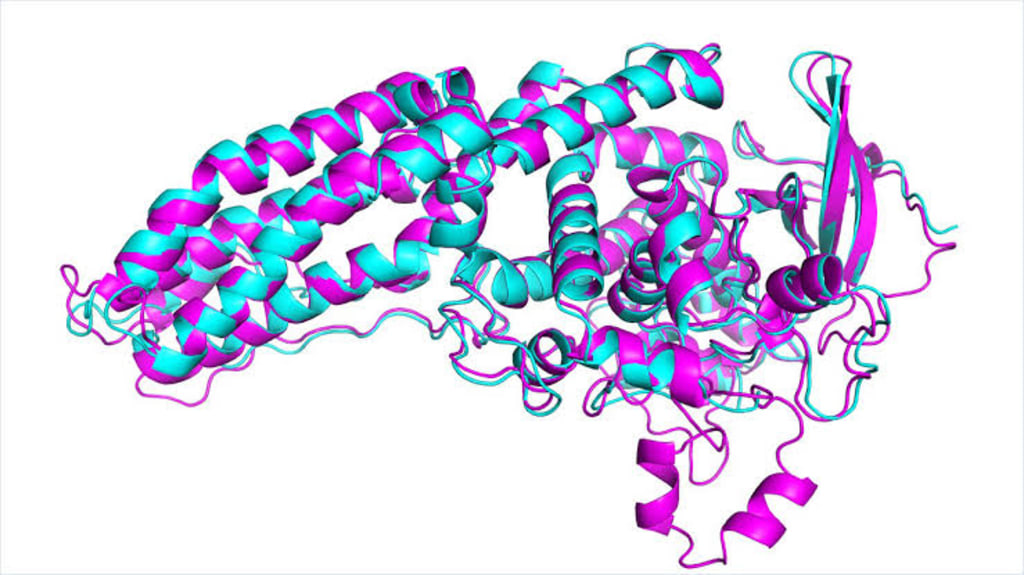
In November 2021, the world was introduced to DeepMind's AlphaFold, a machine learning system that can predict the three-dimensional (3D) structure of proteins with remarkable accuracy. This breakthrough development has solved one of the biggest mysteries in biology - the protein folding problem - which has puzzled scientists for over 50 years. In this essay, we will explore the significance of AlphaFold and the impact it will have on the future of biological research.
Proteins are the workhorses of the human body, performing a vast array of essential functions, from catalyzing chemical reactions to transmitting signals between cells. The shape of a protein is crucial to its function, and it is determined by its 3D structure, which is defined by the sequence of amino acids that make up the protein chain. However, predicting the 3D structure of a protein from its amino acid sequence alone has been a notoriously difficult challenge, with many different approaches attempted over the years. The protein folding problem has been described as the "holy grail" of biology, as its solution would have far-reaching implications for medicine and biotechnology.
Enter DeepMind's AlphaFold, which uses a neural network to predict the 3D structure of a protein from its amino acid sequence. The system was trained on a dataset of over 170,000 protein structures, using a technique known as supervised learning. AlphaFold's predictions were then tested against experimental data and other computational methods, and in most cases, its predictions were found to be highly accurate. The system was able to predict the structure of proteins that had never been seen before, including those from the SARS-CoV-2 virus that causes COVID-19.
The implications of AlphaFold's success are enormous. The ability to accurately predict protein structures opens up new avenues for drug discovery and development, as well as for understanding the molecular basis of disease. For example, many diseases, such as Alzheimer's and Parkinson's, are caused by misfolded proteins, and understanding the mechanisms behind protein folding could lead to new treatments. Furthermore, AlphaFold's success has already sparked renewed interest in the field of structural biology, with researchers now eager to use the system to solve long-standing problems.
However, there are also potential risks associated with the widespread use of AlphaFold. For example, the system could be used to design new proteins that could be used as bioweapons, or it could be used to create new strains of viruses that are more virulent or infectious. There are also ethical considerations around who will have access to the technology and how it will be used.
One of the most significant implications of AlphaFold's success is its potential impact on drug discovery. Many diseases are caused by proteins that are misfolded or mutated, and understanding the structure of these proteins could lead to new treatments. AlphaFold's ability to predict protein structures with high accuracy could greatly accelerate the drug discovery process, as researchers would be able to design drugs that specifically target the structures of disease-causing proteins.
Another area where AlphaFold could have a significant impact is in the field of synthetic biology. Synthetic biologists aim to design and engineer new biological systems, such as proteins and enzymes, with specific functions. AlphaFold's ability to predict protein structures could be used to design new proteins with specific functions, such as enzymes that break down pollutants or proteins that target cancer cells.
AlphaFold's success has also sparked renewed interest in the field of structural biology. Structural biologists use techniques such as X-ray crystallography and nuclear magnetic resonance (NMR) to determine protein structures experimentally. However, these techniques are time-consuming and expensive, and can only be used for a limited number of proteins. AlphaFold's ability to predict protein structures could greatly accelerate the pace of structural biology research, as researchers would be able to focus on proteins that are difficult to study experimentally.
One of the challenges of using AlphaFold in research is the fact that the system is currently not widely available. While DeepMind has made the system available to some researchers through its AlphaFold Protein Structure Database, access to the system is limited. Furthermore, the system is computationally intensive, requiring large amounts of computing power and specialized hardware. As a result, many researchers may not have the resources to use AlphaFold in their research.
Finally, there are also ethical and societal implications associated with AlphaFold's success. As mentioned earlier, the system could be used to design new proteins for nefarious purposes, such as bioweapons. It is important that the technology is developed and used responsibly, and that regulations are put in place to prevent its misuse. Furthermore, there are also concerns around who will have access to the technology and how it will be used. It is important that the benefits of AlphaFold's success are shared equitably, and that the technology is not used to further widen existing inequalities.
In conclusion, DeepMind's AlphaFold represents a major milestone in the field of biology, solving a problem that has puzzled scientists for over 50 years. The implications of its success are vast, from drug discovery to understanding the molecular basis of disease. However, there are also potential risks associated with its use, and it is important that the technology is developed and used responsibly. Overall, AlphaFold is a testament to the power of machine learning and the potential of artificial intelligence to transform the field of biology.
About the Creator
9FunFacts
belief in or acceptance of something as true.






Comments
There are no comments for this story
Be the first to respond and start the conversation.